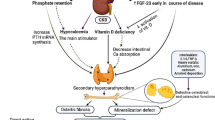Abstract
Evidence is accumulating to indicate that certain abnormalities in mineral metabolism and/or their clinical management can lead to the development of vascular and soft tissue calcifications in patients with end-stage renal disease. Although the long-term consequences of vascular calcification in chronic renal failure have yet to be fully defined, the disorder may contribute to the high mortality rate from cardiovascular causes in patients undergoing long-term dialysis. The relationship between vascular calcification and cardiovascular disease in those with end-stage renal disease needs to be thoroughly evaluated, and substantial changes in the clinical management of patients undergoing dialysis may be appropriate. Phosphate retention and hyperphosphatemia have long been recognized as contributors to vascular and soft tissue calcification in chronic renal failure. Several recent reports indicate, however, that the use of large oral doses of calcium as phosphate-binding agents particularly in patients with persistently elevated serum phosphorus levels, may increase the risk of vascular calcification. Concurrent therapy with supra-physiological doses of calcitriol and other vitamin D sterols to manage secondary hyperparathyroidism leads to episodes of hyperphosphatemia and hypercalcemia, which can further aggravate soft tissue and vascular calcification. The phosphate-binding ion exchange resin sevelamer is now available for clinical use in the United States. It does not contain either calcium or aluminum, and other calcium- and aluminum-free phosphate-binding agents are being developed. These compounds make it possible to manage phosphate retention in patients with chronic renal failure without the risks associated with the sustained ingestion of large daily doses of calcium or aluminum. Several new vitamin D analogs are now available to treat secondary hyperparathyroidism due to chronic renal failure. These compounds may be less likely than calcitriol to enhance intestinal calcium and phosphorus absorption and to promote calcium and phosphorus release from bone. The therapeutic use of new vitamin D sterols as alternatives to calcitriol may permit clinicians to effectively manage secondary hyperparathyroidism while reducing the risks of soft tissue calcification in patients who require vitamin D therapy.
Similar content being viewed by others
Author information
Authors and Affiliations
Additional information
Received: July 27, 2000 / Accepted: July 27, 2000
About this article
Cite this article
Goodman, W. Renal osteodystrophy: present and future. Clin Exp Nephrol 4, 182–186 (2000). https://doi.org/10.1007/s101570070019
Issue Date:
DOI: https://doi.org/10.1007/s101570070019




